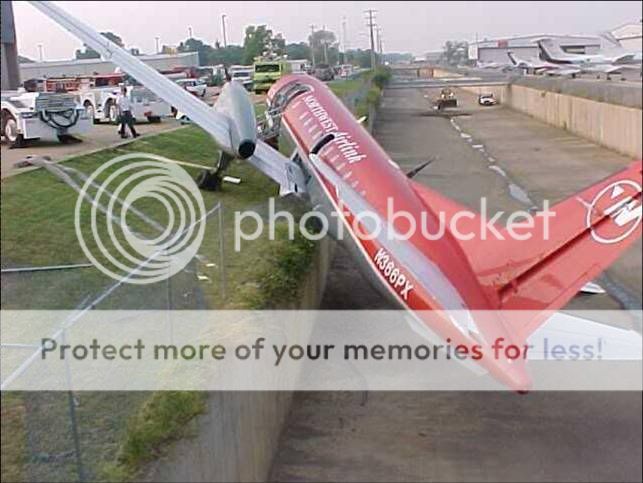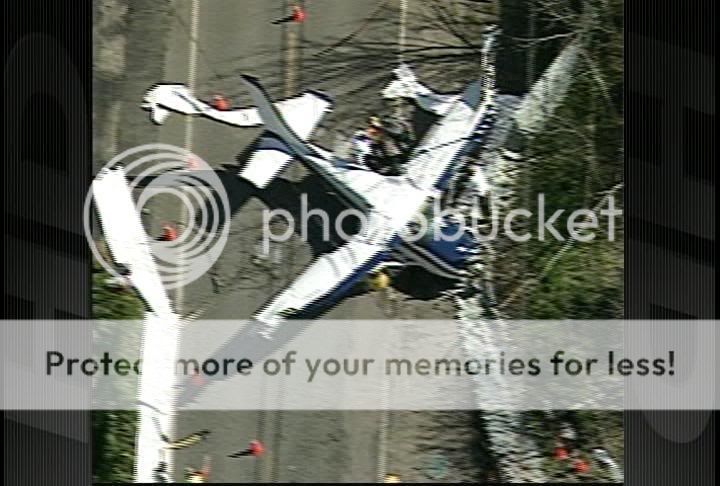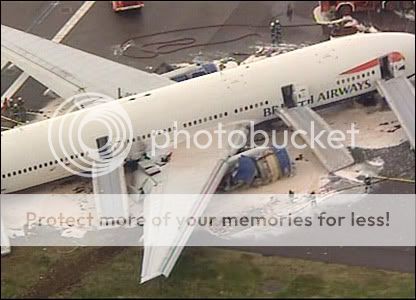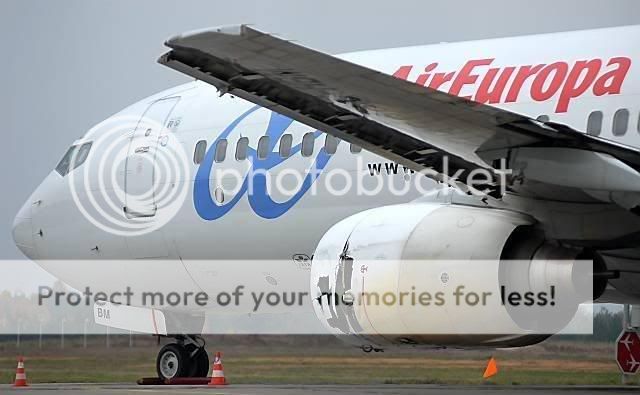It looks like you're using an Ad Blocker.
Please white-list or disable AboveTopSecret.com in your ad-blocking tool.
Thank you.
Some features of ATS will be disabled while you continue to use an ad-blocker.
share:
Originally posted by Pilgrum
The blast from the engine is highly concentrated for efficiency so to be badly affected by it directly you'd have to be lined up with the engine within about 10' of centre and fairly close as well.
From the witness statements, flight recorder and other evidence the plane had a nose down attitude (descending) and was high enough above the roadway for the direct blast to not affect people and vehicles directly.
Over 20 of the witnesses identified the plane as having AA markings and a handful of experienced observers even recognised it as a Boeing 757. Witnesses watched it hit light poles then the building and explode.
1. Actaully the source i have states 20 feet around engine exhaust would be effected by jet blast.
2. Witnesses could not agree on what type of plane it was. Also a witness stated that they did not know what hit the Pentagon, they were told later it was a 757. These witness statements would not hold up in court.
3. Witness also stated the the plane rocked cars, and hit an antenna.
4. According to a source i have a airliner even hitting (1) lightpole can shear off a large section of wing. The plane at the Pentagon is stated to have hit 5 light poles.
Originally posted by ULTIMA1
4. According to a source i have a airliner even hitting (1) lightpole can shear off a large section of wing. The plane at the Pentagon is stated to have hit 5 light poles.
I would like to read this source out of curiosity.
Until I do, the only explanation I can think of is that if you hit an object closer to its base, it can resist the force better.
If you hit something as tall as a light pole around the top, you instill a much larger moment at the bottom (lever action) and it doesn't require that much force to knock it over.
Moment = Force x Distance.
For the same moment needed to knock something over, increasing the distance decreases the required force.
Originally posted by HLR53K
Until I do, the only explanation I can think of is that if you hit an object closer to its base, it can resist the force better.
The plane in question hit a lightpole, shearing off a section of the wing. This happened at takeoff speeds so if figure the impact of a plane hitting poles at near 500mph would be more impact.
www.lasvegassun.com...
...It clipped a light pole in the National Car Rental parking lot, 2,760 feet past the runway, shearing off 18 feet of the left wing, then brushed the roof of the Avis Rent A Car building. The engines stalled.
reply to post by ULTIMA1
I'm getting a "Page Not Found" error from your link. Does the article have a name I can search for?
I'm getting a "Page Not Found" error from your link. Does the article have a name I can search for?
Originally posted by HLR53K
I'm getting a "Page Not Found" error from your link. Does the article have a name I can search for?
Oh sorry about that, its an old link i did not know it was not working anymore. I will see if there is a newer link, or any newer infomation about airliners hitting light poles.
[edit on 18-5-2008 by ULTIMA1]
reply to post by ULTIMA1
I managed to dig up this tiny blurb about an Air Europa Boeing 737-800 (October, 2007 Katowice, Poland) running through what looks like 10 meter tall approach lights.
www.cargolaw.com...
Roughly half-way down the page.
The wing and engine took some damage, but they're still intact.
[edit on 18-5-2008 by HLR53K]
I managed to dig up this tiny blurb about an Air Europa Boeing 737-800 (October, 2007 Katowice, Poland) running through what looks like 10 meter tall approach lights.
www.cargolaw.com...
Roughly half-way down the page.
The wing and engine took some damage, but they're still intact.
[edit on 18-5-2008 by HLR53K]
www.ntsb.gov...
www.candgnews.com...
According to witnesses, flight 255 began its takeoff rotation about 1,200 to 1,500 feet from the end of the runway and lifted off near the end of the runway. After liftoff, the wings of the airplane rolled to the left and the right about 35 degrees in each direction. The airplane collided with obstacles northeast of the runway when the left wing struck a light pole located 2,760 feet beyond the end of the runway.
www.candgnews.com...
The aircraft struck a light pole, causing the left wing to separate, before impacting other light poles, a rental car facility and vehicles on the ground. It broke apart and burst into flames as it impacted an embankment and skidded down Middlebelt near I-94, scattering victims and debris in its path.
Photos that show wings normally shear off when hitting an obsticle.
i114.photobucket.com...
i114.photobucket.com...
i114.photobucket.com...
i114.photobucket.com...
reply to post by ULTIMA1
ULTIMA, you cherry-pickedd again, this time you're talking about Northwest 255...an MD-80....and seeminly didn't read the full NTSB report.
Your other link was written by someone 20 YEARS after the accident, who made an assumption about a light pole being able to 'shear a wing off'.
Horse puckey!
If the wings are that fragile the airplane wouldn't survive it's first bout with turbulence!!!
Or else, it's on bloody massively strong light pole....made of titanium, was it? You do realize that objects such as light poles are frangible, don't you?
ULTIMA, you cherry-pickedd again, this time you're talking about Northwest 255...an MD-80....and seeminly didn't read the full NTSB report.
Your other link was written by someone 20 YEARS after the accident, who made an assumption about a light pole being able to 'shear a wing off'.
Horse puckey!
If the wings are that fragile the airplane wouldn't survive it's first bout with turbulence!!!
Or else, it's on bloody massively strong light pole....made of titanium, was it? You do realize that objects such as light poles are frangible, don't you?
Originally posted by weedwhacker
ULTIMA, you cherry-pickedd again, this time you're talking about Northwest 255...an MD-80....and seeminly didn't read the full NTSB report.
Yes i read the report. If you read my post it stated that a wing was sheared off by a light pole. Which is supported by the sources.
I did not state what type of plane, just proving the point that an alirliners wing can be sheared off by hitting an obsticle.
How many more sources do i need to post to show that an airliners wings can be sheared off by hitting an obsticle?
[edit on 18-5-2008 by ULTIMA1]
reply to post by ULTIMA1
Again....you used the words 'normally' and 'obstacle'....
The AAL MD-80 in your picture ran off the end of the runway, into a ditch...and broke apart at a relatively slow speed...it was a 'survivable' accident.
Your second picture looks familiar...was that in Teterboro, NJ bt any chance? If it is, it's another case of a runway over-run, again fairly slow
In those cases, the shearing/twisting/bending forces will act to cause airframe destruction.
Striking a frangible 4-inch diameter light pole at 500 MPH is entirely different....it will leave a large dent, sure....but in a split second the airplane was destroyed when it hit the building....a little somwthing called 'kinetic energy' has some responsibilty in this, as well. people tend to forget that.
Again....you used the words 'normally' and 'obstacle'....
The AAL MD-80 in your picture ran off the end of the runway, into a ditch...and broke apart at a relatively slow speed...it was a 'survivable' accident.
Your second picture looks familiar...was that in Teterboro, NJ bt any chance? If it is, it's another case of a runway over-run, again fairly slow
In those cases, the shearing/twisting/bending forces will act to cause airframe destruction.
Striking a frangible 4-inch diameter light pole at 500 MPH is entirely different....it will leave a large dent, sure....but in a split second the airplane was destroyed when it hit the building....a little somwthing called 'kinetic energy' has some responsibilty in this, as well. people tend to forget that.
Originally posted by ULTIMA1
Originally posted by weedwhacker
ULTIMA, you cherry-pickedd again, this time you're talking about Northwest 255...an MD-80....and seeminly didn't read the full NTSB report.
Yes i read the report. If you read my post it stated that a wing was sheared off by a light pole. Which is supported by the sources.
I did not state what type of plane, just proving the point that an alirliners wing can be sheared off by hitting an obsticle.
How many more sources do i need to post to show that an airliners wings can be sheared off by hitting an obsticle?
[edit on 18-5-2008 by ULTIMA1]
NO, NO, NO! I asked 'did you read the NTSB report?' and you said, 'yes'.
Now...let's look at your response, up above there very carefully. Are you playing a word game?
It's your first sentence...in that sentence you refer to 'it', which means in YOUR post....but you're leaving the impression that the full NTSB report stated that the light pole sheared off the wing. That is incorrect, and misleading. The coup de gras wass 'it was supported by the sources' !!!
You are playing loose and fast with semantics, please be more careful.
Originally posted by weedwhacker
Your second picture looks familiar...was that in Teterboro, NJ bt any chance? If it is, it's another case of a runway over-run, again fairly slow
.
Yes the wings were sheared off hitting a wall at a fairly slow speed. So that would would mean the plane hitting the Pentagon at a faster speed would have surely SHEARED OFF THE WINGS.
Again how many sources do i have to show before you will admit that an airliners wings will be sheared off by hitting obsticles?
[edit on 18-5-2008 by ULTIMA1]
Originally posted by weedwhacker
NO, NO, NO! I asked 'did you read the NTSB report?' and you said, 'yes'.
but you're leaving the impression that the full NTSB report stated that the light pole sheared off the wing. That is incorrect, and misleading. The coup de gras wass 'it was supported by the sources' !!!
1. YES i did READ the NTSB report.
2. I have other sources that have witnesses stating the wing was sheared off when it the first light pole which casued it to hit other poles and the roof of the building.
ULTIMA, I tell you what....I will go to L'Enfant Plaza tomorrow to search their archives on NW255
the address, by snail mail, is 490 L'Enfant Plaza, SW Washington, DC 20594. Their toll-free number is (800) 877-6799
They archive all reports older than ten years...otherwise, most are available online, in a pdf format.
the address, by snail mail, is 490 L'Enfant Plaza, SW Washington, DC 20594. Their toll-free number is (800) 877-6799
They archive all reports older than ten years...otherwise, most are available online, in a pdf format.
Here are some pictures of airplane crashes.
One ran into a ditch:

One landed onto a highway and clearly plowed through some ground objects:

These three are from Air France and British Airways which dragged themselves on the airliner's belly. The engines are completely destroyed, but the wings are definitely intact:



Crashes are a particular thing. You can't just look at one article and take that to be fact for every other crash that happens.
As I have also posted, the Polish 737 clearly ran over 10 meter tall landing lights, but yet the wings were not sheared off. Damaged, but not sheared off.
So it's possible for an aircraft to hit a high ground object and still remain intact.
[edit on 18-5-2008 by HLR53K]
One ran into a ditch:

One landed onto a highway and clearly plowed through some ground objects:

These three are from Air France and British Airways which dragged themselves on the airliner's belly. The engines are completely destroyed, but the wings are definitely intact:



Crashes are a particular thing. You can't just look at one article and take that to be fact for every other crash that happens.
As I have also posted, the Polish 737 clearly ran over 10 meter tall landing lights, but yet the wings were not sheared off. Damaged, but not sheared off.
So it's possible for an aircraft to hit a high ground object and still remain intact.
[edit on 18-5-2008 by HLR53K]
reply to post by ULTIMA1
Did you SEE the photo that HLR kindly provided?!? Please explain to us how that B737 hit FOUR light poles, and landed safely.
Go ahead, go look....I'll wait....
Did you SEE the photo that HLR kindly provided?!? Please explain to us how that B737 hit FOUR light poles, and landed safely.
Go ahead, go look....I'll wait....
reply to post by HLR53K
The last two, of the 777....that was fairly recent, and very bizarre.
Have they released a final report yet? Was it a dual flame-out, or (as I suspect) bird ingestion?
The last two, of the 777....that was fairly recent, and very bizarre.
Have they released a final report yet? Was it a dual flame-out, or (as I suspect) bird ingestion?
reply to post by weedwhacker
Here they are for anyone who doesn't want to search for it.
The approach lights:

The resulting damage to the wing and engine nacelle:

Damaged, yes. Sheared completely off, nope.
Here they are for anyone who doesn't want to search for it.
The approach lights:

The resulting damage to the wing and engine nacelle:

Damaged, yes. Sheared completely off, nope.
new topics
-
Does the Trump win mean No More Taylor Swift??
Politicians & People: 2 hours ago -
Trump-appointed judge blocks Biden administration overtime rule
Social Issues and Civil Unrest: 4 hours ago -
Don't cry do Cryo instead
General Chit Chat: 9 hours ago -
Tariffs all around, Except for ...
Dreams & Predictions: 11 hours ago
top topics
-
Don't cry do Cryo instead
General Chit Chat: 9 hours ago, 10 flags -
Gen Flynn's Sister and her cohort blow the whistle on DHS/CBP involvement in child trafficking.
Whistle Blowers and Leaked Documents: 16 hours ago, 8 flags -
Does the Trump win mean No More Taylor Swift??
Politicians & People: 2 hours ago, 7 flags -
Tariffs all around, Except for ...
Dreams & Predictions: 11 hours ago, 5 flags -
Trump-appointed judge blocks Biden administration overtime rule
Social Issues and Civil Unrest: 4 hours ago, 5 flags
active topics
-
The art of being offended
Social Issues and Civil Unrest • 51 • : Irishhaf -
How can you defend yourself when the police will not tell you what you did?
Posse Comitatus • 87 • : Irishhaf -
Trump sues media outlets -- 10 Billion Dollar lawsuit
US Political Madness • 46 • : network dude -
Don't cry do Cryo instead
General Chit Chat • 7 • : Kaiju666 -
Does the Trump win mean No More Taylor Swift??
Politicians & People • 13 • : network dude -
Instrumental Surf Music - Origins to the Present Day
Music • 243 • : underpass61 -
Post A Funny (T&C Friendly) Pic Part IV: The LOL awakens!
General Chit Chat • 7777 • : bluemooone44 -
Trump-appointed judge blocks Biden administration overtime rule
Social Issues and Civil Unrest • 3 • : xuenchen -
Mike Tyson returns 11-15-24
World Sports • 58 • : belkide -
WATCH LIVE: US Congress hearing on UFOs, unidentified anomalous phenomena
Aliens and UFOs • 88 • : Cvastar
